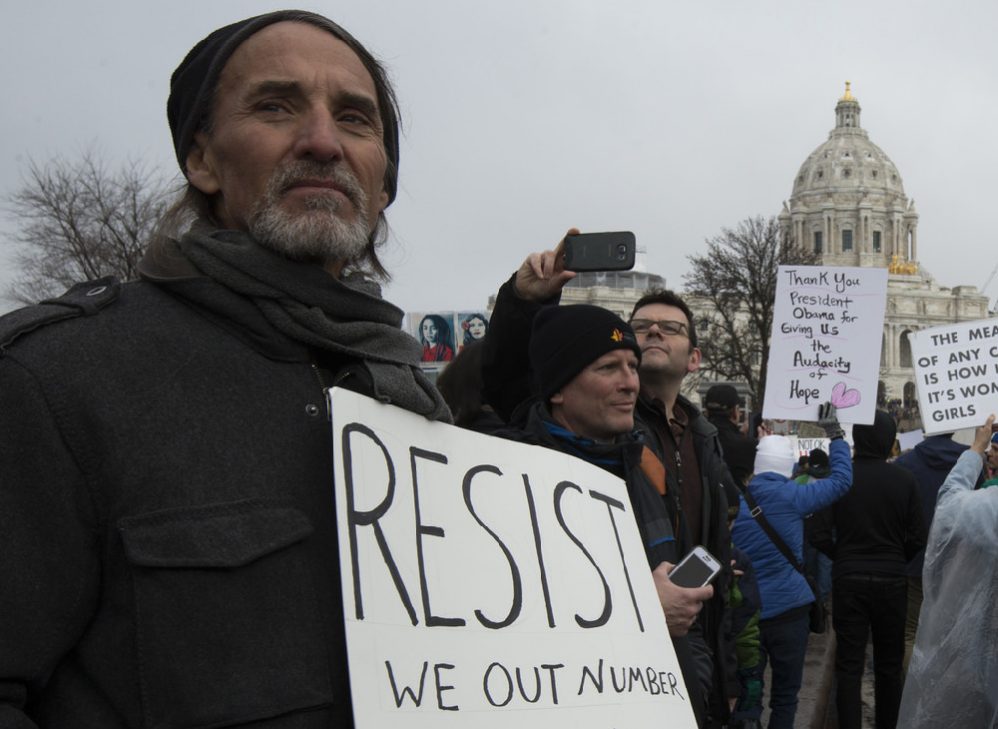In the wake of the 2008 election, Democrats had won the presidency. They held 59 Senate seats and a 76-person majority in congress. There was a talk of a permanent Democratic majority, and the GOP appeared to be in complete, powerless disarray. In response, a grassroots protest movement emerged. Considered more or less a joke at first, the Tea Party would change the face of American politics. And just eight years later, it would help restore Republican political power.
Now, as Democrats face the dark political wilderness, they too have launched a protest movement, loosely referred to as “The Resistance.” It is tempting to compare these historical moments. Many on the Left have begun to not only compare the Resistance to the Tea Party but to use it as a model. This means more than protesting and attending town halls—it also means organizing and promoting candidates who will challenge Trump.
But for all the similarities of situation and tactics, there are several specific reasons why the Resistance is unlikely to succeed as the Tea Party did. Becoming the new “party of no” may be the best option progressives have to fight the president—but progressivism has baked into it aspects that make it very different from the Tea Party they seek to emulate.
1. Progressives Have Embraced Intersectionality
For those unfamiliar with the term, intersectionality refers to the ways in which marginalized people overlap in the hierarchy of oppression. So being gay and black makes you oppressed, but if you are cis (not transgender), your gender privilege intersects with your oppression. If that idea gives you a headache, it should. It also helps to explain why progressives so often wind up at each other’s throats.
This phenomenon was on display at the Women’s March on Washington. Originally organized by two white people, calls came almost instantly to diversify its leadership. The problem with this is that it leads to ever more radical positions—when the lesbian, Eskimo, midget, left-handed, ninja albinos demand inclusion of their cause in the platform. This was one of the things that led to the failure of Occupy Wall Street, as more moderate voices were pushed to the side.
The Resistance believes that diversity is its strength. But diversity can also be a profound weakness, one that has haunted many progressive movements. The Tea Party faced almost no similar divisions, and more or less avoided such internecine struggles.
2. They Have No Unifying Issue To Rally Around
Related to the problem of intersectionality is the Resistance’s lack of a unifying issue. The Tea Party was laser-focused on government spending, both regarding the bailouts and eventually the Affordable Care Act. Protests, in general, are more successful when they oppose something concrete—like a war or a specific law. We saw evidence of this in the airport protests over the president’s immigration executive order. Politicians, the courts, and the media followed their lead. In some measure, they were able to claim victory.
But the Resistance is about much more than immigration: it is opposed to Trump, not any one or two of his policies. This will make the movement a mile wide and an inch deep. The public will not be able to process all their complaints at once, and politicians will not be able to concentrate their fire.
3. Progressives’ Bubble Won’t Help Them
The Resistance likes to point out that Hillary Clinton received more votes than Trump. And it is an important point: Clinton came much closer to winning the 2016 election than John McCain did in 2008. But the disparity between the popular vote and the Electoral College reveals a telling weakness for Democrats in national elections. Progressive voters are densely packed into small geographic areas where they dominate.
It may well be that the Resistance has greater overall participation than the Tea Party did. But it will be focused in progressive cities and on college campuses. This will not give the Resistance the kind of reach that the Tea Party had. Even if it succeeds in motivating voters, it will only enhance already overwhelming advantages in places where Democrats already win.
4. The Resistance’s Use Of Violence Is Counterproductive
As we saw during the recent Berkeley riots and the assault on Richard Spencer caught on video, there is an element of the Resistance that is willing to use violence to achieve its political ends. Progressives will argue that this is a small percentage, just as the Tea Party did when confronted with allegations of racism. But thus far, too many progressives have been apologists for such violence. Somehow they are engaged in a debate as to whether punching political opponents is okay.
This is an old story on the Left. It’s how William Ayers, a convicted political terrorist, and a member of the Weather Underground, can be friends with former President Obama. Rather than say “there is no place for this here,” as the Tea Party did with racism, progressives see their violent elements as having similar aims and different methods.
Any protest organizer will tell you that seeing grandmothers and toddlers is much better messaging than seeing masked thugs setting things on fire. But if the Resistance cannot firmly and totally reject such methods, they deserve the stain that comes with them. And the American people will associate them with that kind of madness.
There Are Some Caveats Worth Considering
For the reasons listed above, it is unlikely that the Resistance can duplicate the Tea Party’s success. After all, the political turnaround it achieved in eight years may be unprecedented in modern American history. But the good news for the Resistance is that they don’t have to. Democrats are not in nearly as deep of a hole as the GOP was in 2009. Democrats trail Republicans by only 47 votes in the House and two in the Senate.
This is why some Democrats—including moderate congressman Tim Ryan, whose attempt to be minority leader fizzled—want a very different approach from the Resistance. Rather than protest and yell, the few moderates left to see a calmer path: one that requires not a political sea change but winning back a few frustrated voters who were swayed by Trump.
At the moment, it does not appear that the moderates are winning the day. Just as the Tea Party stuck it to the GOP establishment, the Resistance seems eager for a similar fight, even with vaguely moderate Democrats. Most Republicans say such a choice will turn Trump into a two-term President. But there are reasons to temper such optimism.
The Resistance Will Be Formidable, Even If It Isn’t Successful
The first reason is Trump himself. Just as Obama launched unpopular policies that fueled the Tea Party, Trump could do or say things that keep the Resistance energized and relevant. He hasn’t been president long, but thus far the size and sustained nature of protests have been impressive. The progressive protest networks, which certainly do have their professional elements, are succeeding in bringing many regular people into the street.
A second reason is that in politics, an offense is better than defense. As Obama found out, popular change is easier to promise than it is to deliver. The party out of power can focus on pie-in-the-sky schemes that haven’t been tested. The party in power has to slog through reality and build a case that they are better than a hypothetical alternative.
Short of some unforeseeable détente between the president and his progressive detractors, the Resistance is likely to have legs. It may even succeed in becoming an effective political organization, as the Tea Party did.
But the Resistance faces structural disadvantages that the Tea Party did not. If it can be a broad-based movement, tolerant of differing philosophies of progressivism, it has a chance to sway opinions and move votes. But if moderate, or as progressives would say, privileged voices are pushed to the side; it will double down on recent failures. The Resistance is not the Tea Party and it can’t win the way Tea Party did. But for now anyway, it looks like that is exactly what is it going to try to do.





